Characterization and Pathogenicity of Fusarium Species Associated with Soybean Pods in Maize/Soybean Strip Intercropping
Abstract
1. Introduction
2. Results
2.1. Identification of Fusarium Species Associated with Intercropped Soybean Pods
2.2. Pathogenicity Test of Fusarium Species
2.3. Frequency of Fusarium Species Associated with Intercropped Soybean Pods
2.4. Diversity of Fusarium Species on Intercropped Soybean in Association with Geographical Origin and Soybean Varieties
3. Discussion
4. Materials and Methods
4.1. Sample Collection and Pathogen Isolation
4.2. Morphological Characterization
4.3. Molecular Identification Based on EF1-α and RPB2 Sequence Analysis
4.4. Pathogenicity Tests
5. Conclusions
Supplementary Materials
Author Contributions
Funding
Acknowledgments
Conflicts of Interest
References
- Yu, H.; Liu, R.; Hu, Y.; Xu, B. Flavor profiles of soymilk processed with four different processing technologies and 26 soybean cultivars grown in China. Int. J. Food Prop. 2017, 20, S2887–S2898. [Google Scholar] [CrossRef]
- Zhang, Q.; Wang, C.; Li, B.; Li, L.; Lin, D.; Chen, H.; Liu, Y.; Li, S.; Qin, W.; Liu, J. Research progress in tofu processing: From raw materials to processing conditions. Crit. Rev. Food Sci. Nutr. 2018, 58, 1448–1467. [Google Scholar] [CrossRef] [PubMed]
- Lee, G.A.; Crawford, G.W.; Liu, L.; Sasaki, Y.; Chen, X. Archaeological soybean (Glycine max) in East Asia: Does size matter? PLoS ONE 2011, 6, e26720. [Google Scholar] [CrossRef] [PubMed]
- Zhang, F.; Chen, X.; Vitousek, P. Chinese agriculture: An experiment for the world. Nature 2013, 497, 33. [Google Scholar] [CrossRef] [PubMed]
- Du, J.; Han, T.; Gai, J.; Yong, T.; Sun, X.; Wang, X.; Yang, F.; Liu, J.; Shu, K.; Liu, W. Maize-soybean strip intercropping: Achieved a balance between high productivity and sustainability. J. Integr. Agric. 2018, 17, 747–754. [Google Scholar] [CrossRef]
- Su, B.; Liu, X.; Cui, L.; Xiang, B.; Yang, W. Suppression of Weeds and Increases in Food Production in Higher Crop Diversity Planting Arrangements: A Case Study of Relay Intercropping. Crop Sci. 2018, 58, 1729–1739. [Google Scholar] [CrossRef]
- Liu, X.; Rahman, T.; Song, C.; Su, B.; Yang, F.; Yong, T.; Wu, Y.; Zhang, C.; Yang, W. Changes in light environment, morphology, growth and yield of soybean in maize-soybean intercropping systems. Field Crop. Res. 2017, 200, 38–46. [Google Scholar] [CrossRef]
- Liu, X.; Rahman, T.; Song, C.; Yang, F.; Su, B.; Cui, L.; Bu, W.; Yang, W. Relationships among light distribution, radiation use efficiency and land equivalent ratio in maize-soybean strip intercropping. Field Crop. Res. 2018, 224, 91–101. [Google Scholar] [CrossRef]
- Yong, T.; Ping, C.; Qian, D.; Qing, D.; Feng, Y.; WANG, X.; LIU, W.; YANG, W. Optimized nitrogen application methods to improve nitrogen use efficiency and nodule nitrogen fixation in a maize-soybean relay intercropping system. J. Integr. Agric. 2018, 17, 664–676. [Google Scholar] [CrossRef]
- Raza, M.A.; Khalid, M.H.B.; Zhang, X.; Feng, L.Y.; Khan, I.; Hassan, M.J.; Ahmed, M.; Ansar, M.; Chen, Y.K.; Fan, Y.F. Effect of planting patterns on yield, nutrient accumulation and distribution in maize and soybean under relay intercropping systems. Sci. Rep. 2019, 9, 4947. [Google Scholar] [CrossRef]
- Raza, M.A.; Feng, L.Y.; van der Werf, W.; Cai, G.R.; Khalid, M.H.B.; Iqbal, N.; Hassan, M.J.; Meraj, T.A.; Naeem, M.; Khan, I. Narrow-wide-row planting pattern increases the radiation use efficiency and seed yield of intercrop species in relay-intercropping system. Food Energy Secur. 2019, 8, e170. [Google Scholar] [CrossRef]
- Chen, P.; Song, C.; Liu, X.; Zhou, L.; Yang, H.; Zhang, X.; Zhou, Y.; Du, Q.; Pang, T.; Fu, Z. Yield advantage and nitrogen fate in an additive maize-soybean relay intercropping system. Sci. Total Environ. 2019, 657, 987–999. [Google Scholar] [CrossRef] [PubMed]
- Qin, A.; Huang, G.; Chai, Q.; Yu, A.; Huang, P. Grain yield and soil respiratory response to intercropping systems on arid land. Field Crop. Res. 2013, 144, 1–10. [Google Scholar] [CrossRef]
- Yang, F.; Wang, X.; Liao, D.; Lu, F.; Gao, R.; Liu, W.; Yong, T.; Wu, X.; Du, J.; Liu, J. Yield response to different planting geometries in maize-soybean relay strip intercropping systems. Agron. J. 2015, 107, 296–304. [Google Scholar] [CrossRef]
- Raza, M.A.; Feng, L.Y.; Khalid, M.H.; Iqbal, N.; Meraj, T.A.; Hassan, M.J.; Ahmed, S.; Chen, Y.K.; Feng, Y.; Wenyu, Y. Optimum leaf excision increases the biomass accumulation and seed yield of maize plants under different planting patterns. Ann. Appl. Biol. 2019, 175, 54–68. [Google Scholar] [CrossRef]
- Keesstra, S.; Nunes, J.; Novara, A.; Finger, D.; Avelar, D.; Kalantari, Z.; Cerdà, A. The superior effect of nature based solutions in land management for enhancing ecosystem services. Sci. Total Environ. 2018, 610, 997–1009. [Google Scholar] [CrossRef]
- Liu, B.; Chen, C.; Lian, Y.; Chen, J.; Chen, X. Long-term change of wet and dry climatic conditions in the southwest karst area of China. Glob. Planet. Chang. 2015, 127, 1–11. [Google Scholar] [CrossRef]
- Liu, J.; Deng, J.; Zhang, K.; Wu, H.; Yang, C.; Zhang, X.; Du, J.; Shu, K.; Yang, W. Pod mildew on soybeans can mitigate the damage to the seed arising from field mold at harvest time. J. Agric. Food Chem. 2016, 64, 9135–9142. [Google Scholar] [CrossRef]
- Liu, J.; Deng, J.; Yang, C.; Huang, N.; Chang, X.; Zhang, J.; Yang, F.; Liu, W.; Wang, X.; Yong, T. Fungal diversity in field mold-damaged soybean fruits and pathogenicity identification based on high-throughput rDNA sequencing. Front. Microbiol. 2017, 8, 779. [Google Scholar] [CrossRef]
- Roy, K.; Ratnayake, S.; McLean, K. Colonization of weeds by Phomopsis longicolla. Can. J. Plant Pathol. 1997, 19, 193–196. [Google Scholar] [CrossRef]
- Barros, G.; Zanon, M.A.; Abod, A.; Oviedo, M.; Ramirez, M.; Reynoso, M.; Torres, A.; Chulze, S. Natural deoxynivalenol occurrence and genotype and chemotype determination of a field population of the Fusarium graminearum complex associated with soybean in Argentina. Food Addit. Contam. Part A 2012, 29, 293–303. [Google Scholar] [CrossRef] [PubMed]
- Barros, G.G.; Zanon, M.S.A.; Chiotta, M.L.; Reynoso, M.M.; Scandiani, M.M.; Chulze, S.N. Pathogenicity of phylogenetic species in the Fusarium graminearum complex on soybean seedlings in Argentina. Eur. J. Plant Pathol. 2014, 138, 215–222. [Google Scholar] [CrossRef]
- Garcia, D.; Barros, G.; Chulze, S.; Ramos, A.J.; Sanchis, V.; Marín, S. Impact of cycling temperatures on Fusarium verticillioides and Fusarium graminearum growth and mycotoxins production in soybean. J. Sci. Food Agric. 2012, 92, 2952–2959. [Google Scholar] [CrossRef] [PubMed]
- Ellis, M.; Broders, K.; Paul, P.; Dorrance, A. Infection of soybean seed by Fusarium graminearum and effect of seed treatments on disease under controlled conditions. Plant Dis. 2011, 95, 401–407. [Google Scholar] [CrossRef]
- Arias, M.M.D.; Leandro, L.F.; Munkvold, G.P. Aggressiveness of Fusarium species and impact of root infection on growth and yield of soybeans. Phytopathology 2013, 103, 822–832. [Google Scholar] [CrossRef]
- Chang, X.; Dai, H.; Wang, D.; Zhou, H.; He, W.; Fu, Y.; Ibrahim, F.; Zhou, Y.; Gong, G.; Shang, J. Identification of Fusarium species associated with soybean root rot in Sichuan Province, China. Eur. J. Plant Pathol. 2018, 151, 563–577. [Google Scholar] [CrossRef]
- Zhang, J.; Xue, A.; Cober, E.; Morrison, M.; Zhang, H.; Zhang, S.; Gregorich, E. Prevalence, pathogenicity and cultivar resistance of Fusarium and Rhizoctonia species causing soybean root rot. Can. J. Plant Sci. 2013, 93, 221–236. [Google Scholar] [CrossRef]
- Chiotta, M.L.; Alaniz Zanon, M.S.; Palazzini, J.M.; Scandiani, M.M.; Formento, A.N.; Barros, G.G.; Chulze, S.N. Pathogenicity of Fusarium graminearum and F. meridionale on soybean pod blight and trichothecene accumulation. Plant Pathol. 2016, 65, 1492–1497. [Google Scholar] [CrossRef]
- Pioli, R.; Mozzoni, L.; Morandi, E.; Menard, M. Disease Notes. Plant Dis. 2004, 88, 220–224. [Google Scholar] [CrossRef]
- Ferrigo, D.; Raiola, A.; Causin, R. Fusarium toxins in cereals: Occurrence, legislation, factors promoting the appearance and their management. Molecules 2016, 21, 627. [Google Scholar] [CrossRef]
- Miedaner, T.; Bolduan, C.; Melchinger, A. Aggressiveness and mycotoxin production of eight isolates each of Fusarium graminearum and Fusarium verticillioides for ear rot on susceptible and resistant early maize inbred lines. Eur. J. Plant Pathol. 2010, 127, 113–123. [Google Scholar] [CrossRef]
- Munkvold, G.P. Epidemiology of Fusarium diseases and their mycotoxins in maize ears. Eur. J. Plant Pathol. 2003, 109, 705–713. [Google Scholar] [CrossRef]
- Pestka, J.J. Deoxynivalenol: Mechanisms of action, human exposure, and toxicological relevance. Arch. Toxicol. 2010, 84, 663–679. [Google Scholar] [CrossRef] [PubMed]
- Nelson, B.D.; Hansen, J.M.; Windels, C.E.; Helms, T.C. Reaction of soybean cultivars to isolates of Fusarium solani from the Red River Valley. Plant Dis. 1997, 81, 664–668. [Google Scholar] [CrossRef]
- Zhang, J.; Xue, A.; Zhang, H.; Nagasawa, A.; Tambong, J. Response of soybean cultivars to root rot caused by Fusarium species. Can. J. Plant Sci. 2010, 90, 767–776. [Google Scholar] [CrossRef]
- Becher, R.; Hettwer, U.; Karlovsky, P.; Deising, H.B.; Wirsel, S.G. Adaptation of Fusarium graminearum to tebuconazole yielded descendants diverging for levels of fitness, fungicide resistance, virulence, and mycotoxin production. Phytopathology 2010, 100, 444–453. [Google Scholar] [CrossRef]
- Chang, K.; Conner, R.; Hwang, S.; Ahmed, H.; McLaren, D.; Gossen, B.; Turnbull, G. Effects of seed treatments and inoculum density of Fusarium avenaceum and Rhizoctonia solani on seedling blight and root rot of faba bean. Can. J. Plant Sci. 2014, 94, 693–700. [Google Scholar] [CrossRef]
- West, J.S.; Holdgate, S.; Townsend, J.A.; Edwards, S.G.; Jennings, P.; Fitt, B.D. Impacts of changing climate and agronomic factors on fusarium ear blight of wheat in the UK. Fungal Ecol. 2012, 5, 53–61. [Google Scholar] [CrossRef]
- Wei, W.; Xu, Y.; Zhu, L.; Zhang, S.; Li, S. Impact of long-term continuous cropping on the Fusarium population in soybean rhizosphere. Yingyong Shengtai Xuebao 2014, 25, 497–504. [Google Scholar]
- Roy, K.; Baird, R.; Abney, T. A review of soybean (Glycine max) seed, pod, and flower mycofloras in North America, with methods and a key for identification of selected fungi. Mycopathologia 2001, 150, 15–27. [Google Scholar] [CrossRef]
- Machado, J.D.C.; Machado, A.Q.; Pozza, E.A.; Machado, C.F.; Zancan, W.L.A. Inoculum potential of Fusarium verticillioides and performance of maize seeds. Trop. Plant Pathol. 2013, 38, 213–217. [Google Scholar] [CrossRef][Green Version]
- Sella, L.; Gazzetti, K.; Castiglioni, C.; Schäfer, W.; Favaron, F. Fusarium graminearum possesses virulence factors common to Fusarium head blight of wheat and seedling rot of soybean but differing in their impact on disease severity. Phytopathology 2014, 104, 1201–1207. [Google Scholar] [CrossRef] [PubMed]
- Zhang, H.; Van der Lee, T.; Waalwijk, C.; Chen, W.; Xu, J.; Xu, J.; Zhang, Y.; Feng, J. Population analysis of the Fusarium graminearum species complex from wheat in China show a shift to more aggressive isolates. PLoS ONE 2012, 7, e31722. [Google Scholar] [CrossRef] [PubMed]
- Alvarez, C.L.; Azcarate, M.P.; Pinto, V.F. Toxigenic potential of Fusarium graminearum sensu stricto isolates from wheat in Argentina. Int. J. Food Microbiol. 2009, 135, 131–135. [Google Scholar] [CrossRef] [PubMed]
- Díaz Arias, M.; Munkvold, G.; Leandro, L. First report of Fusarium proliferatum causing root rot on soybean (Glycine max) in the United States. Plant Dis. 2011, 95, 1316. [Google Scholar] [CrossRef] [PubMed]
- Watanabe, M.; Yonezawa, T.; Lee, K.-I.; Kumagai, S.; Sugita-Konishi, Y.; Goto, K.; Hara-Kudo, Y. Molecular phylogeny of the higher and lower taxonomy of the Fusarium genus and differences in the evolutionary histories of multiple genes. Bmc Evol. Biol. 2011, 11, 322. [Google Scholar] [CrossRef]
- Pedrozo, R.; Little, C.R. Fusarium verticillioides inoculum potential influences soybean seed quality. Eur. J. Plant Pathol. 2017, 148, 749–754. [Google Scholar] [CrossRef]
- Pedrozo, R.; Little, C. The interesting case of soybean seedborne Fusarium spp.: From identity to pathogenicity. Phytopathology 2015, 105, S4. [Google Scholar]
- Osborne, L.E.; Stein, J.M. Epidemiology of Fusarium head blight on small-grain cereals. Int. J. Food Microbiol. 2007, 119, 103–108. [Google Scholar] [CrossRef]
- Backhouse, D. Global distribution of Fusarium graminearum, F. asiaticum and F. boothii from wheat in relation to climate. Eur. J. Plant Pathol. 2014, 139, 161–173. [Google Scholar] [CrossRef]
- Doohan, F.; Brennan, J.; Cooke, B. Influence of climatic factors on Fusarium species pathogenic to cereals. In Epidemiology of Mycotoxin Producing Fungi; Springer: Cham, Switzerland, 2003; pp. 755–768. [Google Scholar]
- Mengistu, A.; Castlebury, L.; Smith, R.; Ray, J.; Bellaloui, N. Seasonal progress of Phomopsis longicolla infection on soybean plant parts and its relationship to seed quality. Plant Dis. 2009, 93, 1009–1018. [Google Scholar] [CrossRef] [PubMed]
- McGee, D. Prediction of Phomopsis seed decay by measuring soybean pod infection. Plant Dis. 1986, 70, 329–333. [Google Scholar] [CrossRef]
- Jeschke, M.R.; Stoltenberg, D.E.; Kegode, G.O.; Sprague, C.L.; Knezevic, S.Z.; Hock, S.M.; Johnson, G.A. Predicted soybean yield loss as affected by emergence time of mixed-species weed communities. Weed Sci. 2011, 59, 416–423. [Google Scholar] [CrossRef]
- Zhou, Y.; Gong, G.; Cui, Y.; Zhang, D.; Chang, X.; Hu, R.; Liu, N.; Sun, X. Identification of Botryosphaeriaceae species causing kiwifruit rot in Sichuan Province, China. Plant Dis. 2015, 99, 699–708. [Google Scholar] [CrossRef] [PubMed]
- Leslie, J.F.; Summerell, B.A. The Fusarium Laboratory Manual; John Wiley & Sons: Hoboken, NJ, USA, 2008. [Google Scholar]
- Chala, A.; Degefu, T.; Brurberg, M.B. Phylogenetically diverse Fusarium species associated with sorghum (Sorghum Bicolor L. Moench) and finger Millet (Eleusine Coracana L. Garten) grains from Ethiopia. Diversity 2019, 11, 93. [Google Scholar] [CrossRef]
- Laurence, M.; Walsh, J.; Shuttleworth, L.; Robinson, D.; Johansen, R.; Petrovic, T.; Vu, T.; Burgess, L.; Summerell, B.; Liew, E. Six novel species of Fusarium from natural ecosystems in Australia. Fungal Divers. 2016, 77, 349–366. [Google Scholar] [CrossRef]
- O’Donnell, K.; Humber, A.R.; Geiser, D.M.; Kang, S.; Park, B.; Robert, V.A.; Crous, P.W.; Johnston, R.P.; Aoki, T.; Rooney, P.A.; et al. Phylogenetic diversity of insecticolous fusaria inferred from multilocus DNA sequence data and their molecular identification via FUSARIUM-ID and Fusarium MLST. Mycologia 2012, 104, 427–445. [Google Scholar] [CrossRef]
- Kumar, S.; Stecher, G.; Tamura, K. MEGA7: Molecular evolutionary genetics analysis version 7.0 for bigger datasets. Mol. Biol. Evol. 2016, 33, 1870–1874. [Google Scholar] [CrossRef]
- Gao, X.; Wu, M.; Xu, R.; Wang, X.; Pan, R.; Kim, H.; Liao, H. Root interactions in a maize/soybean intercropping system control soybean soil-borne disease, red crown rot. PLoS ONE 2014, 9, e95031. [Google Scholar] [CrossRef]
- Alejandro Rojas, J.; Jacobs, J.L.; Napieralski, S.; Karaj, B.; Bradley, C.A.; Chase, T.; Esker, P.D.; Giesler, L.J.; Jardine, D.J.; Malvick, D.K. Oomycete species associated with soybean seedlings in North America—Part I: Identification and pathogenicity characterization. Phytopathology 2016, 107, 280–292. [Google Scholar] [CrossRef]
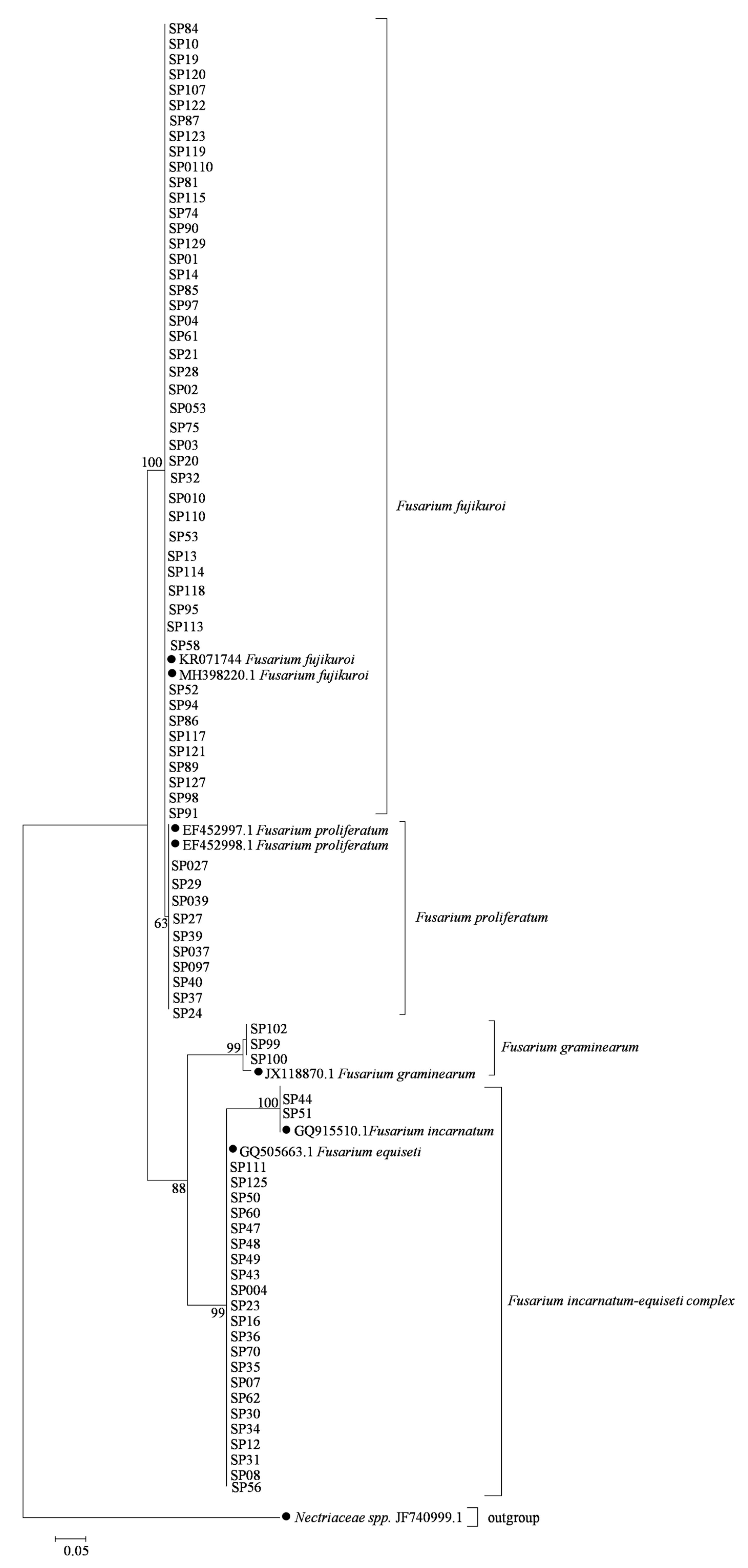
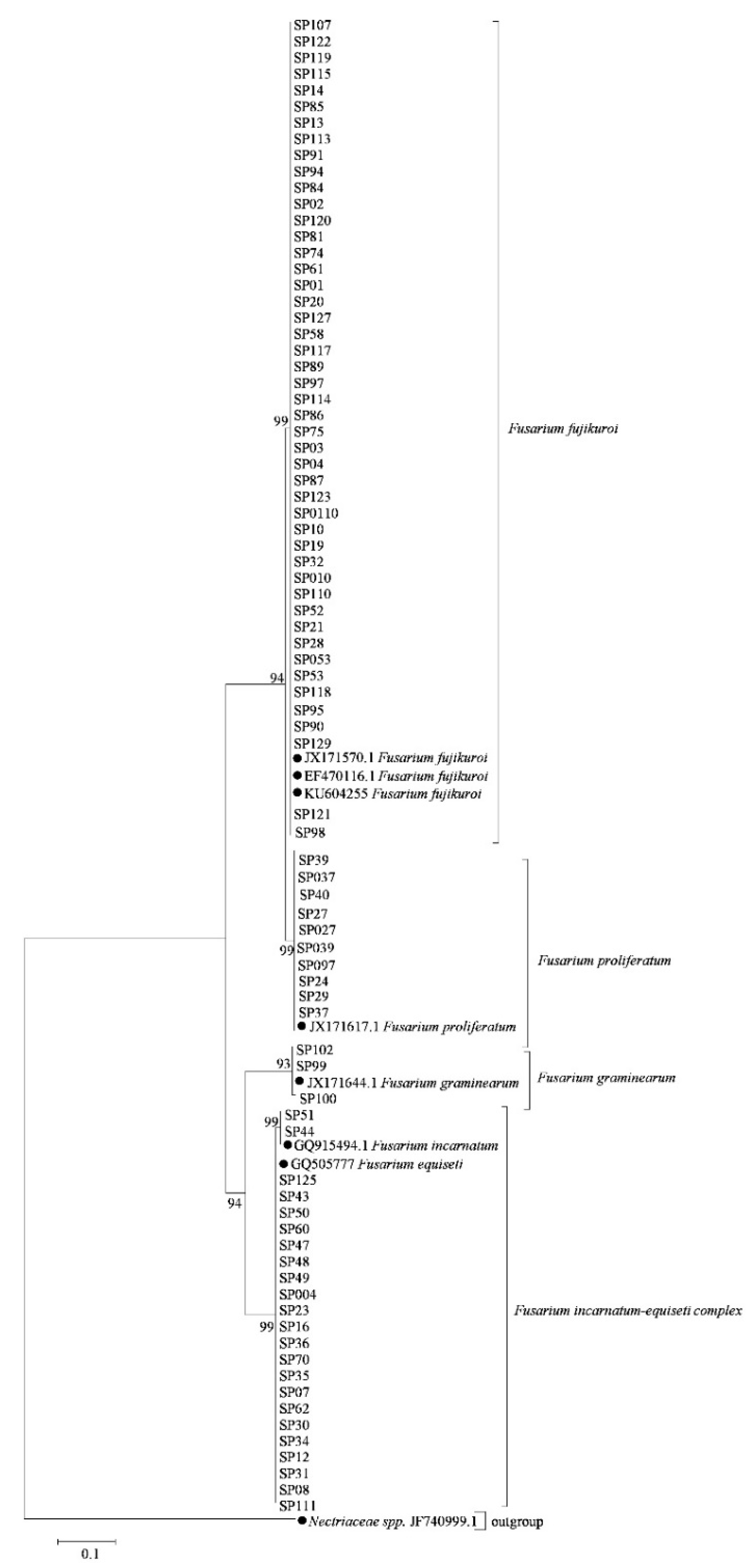
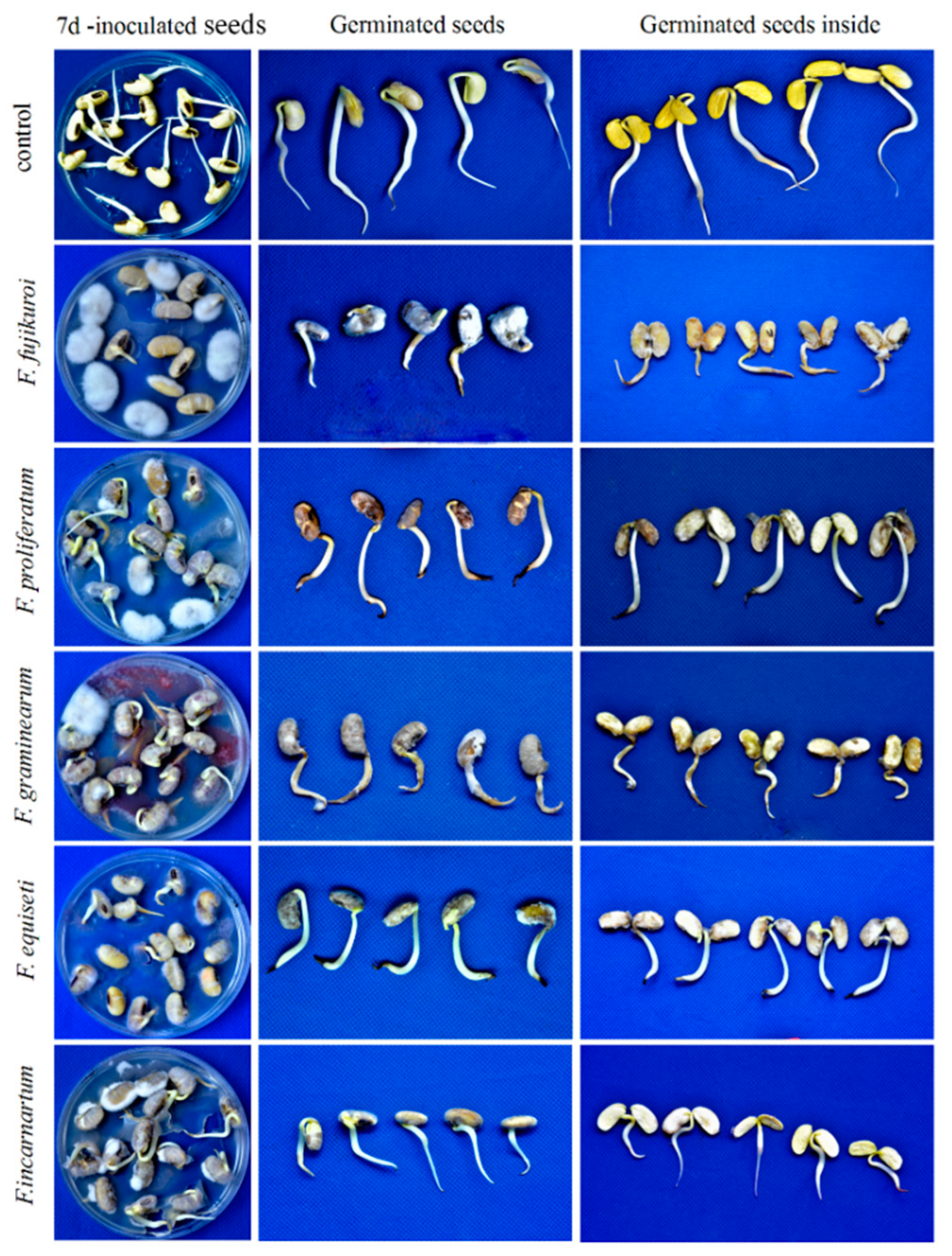
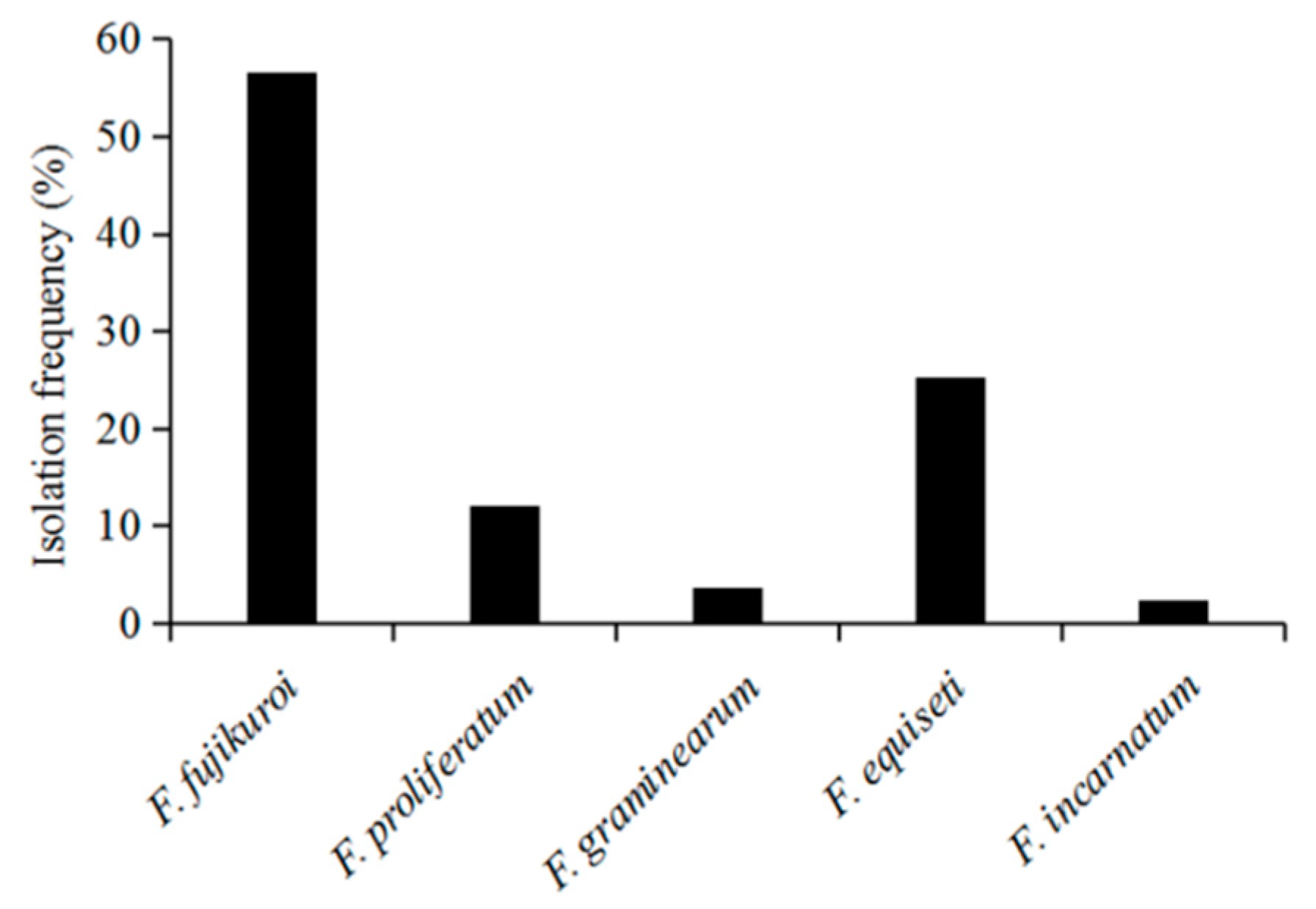
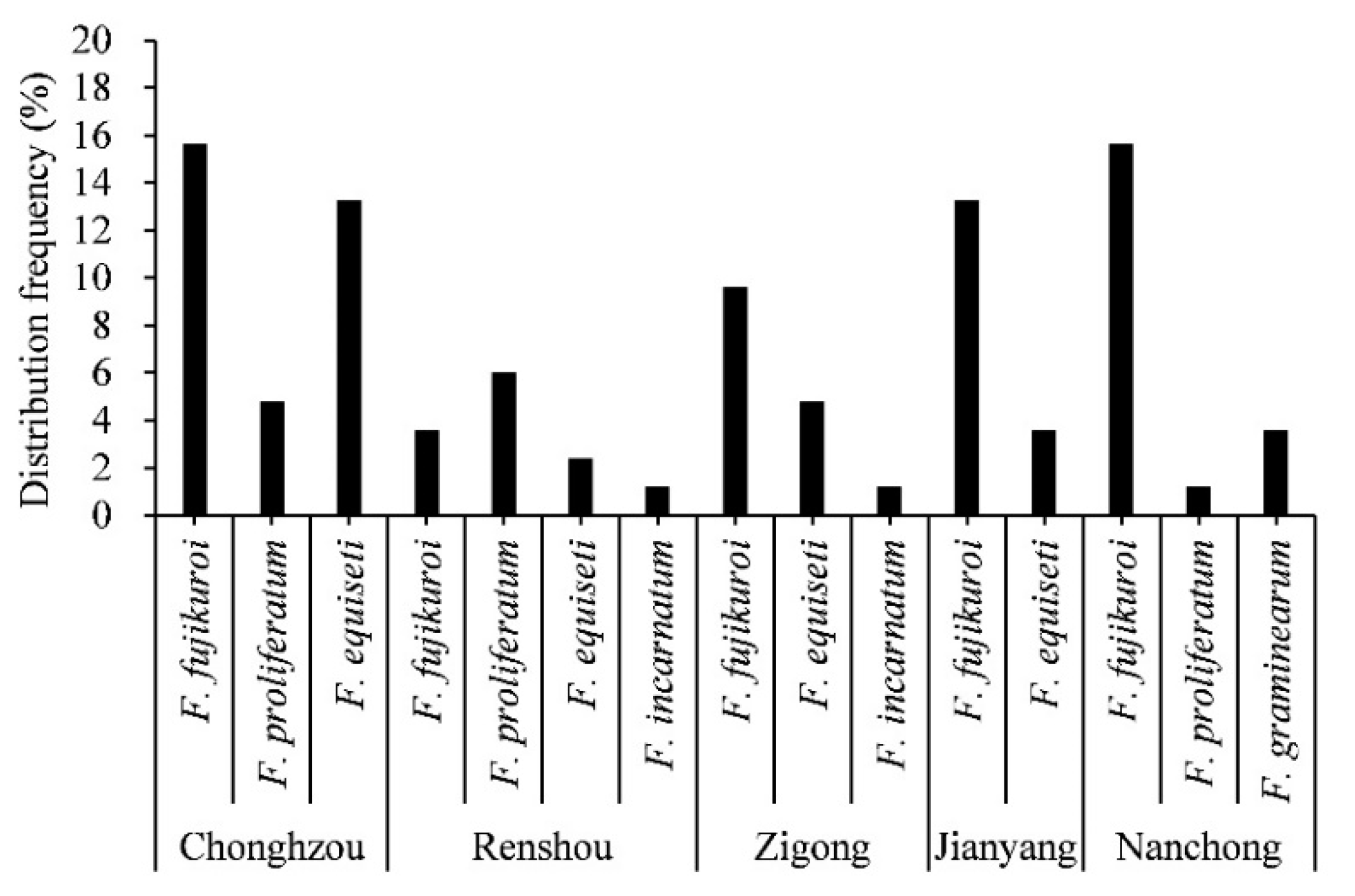
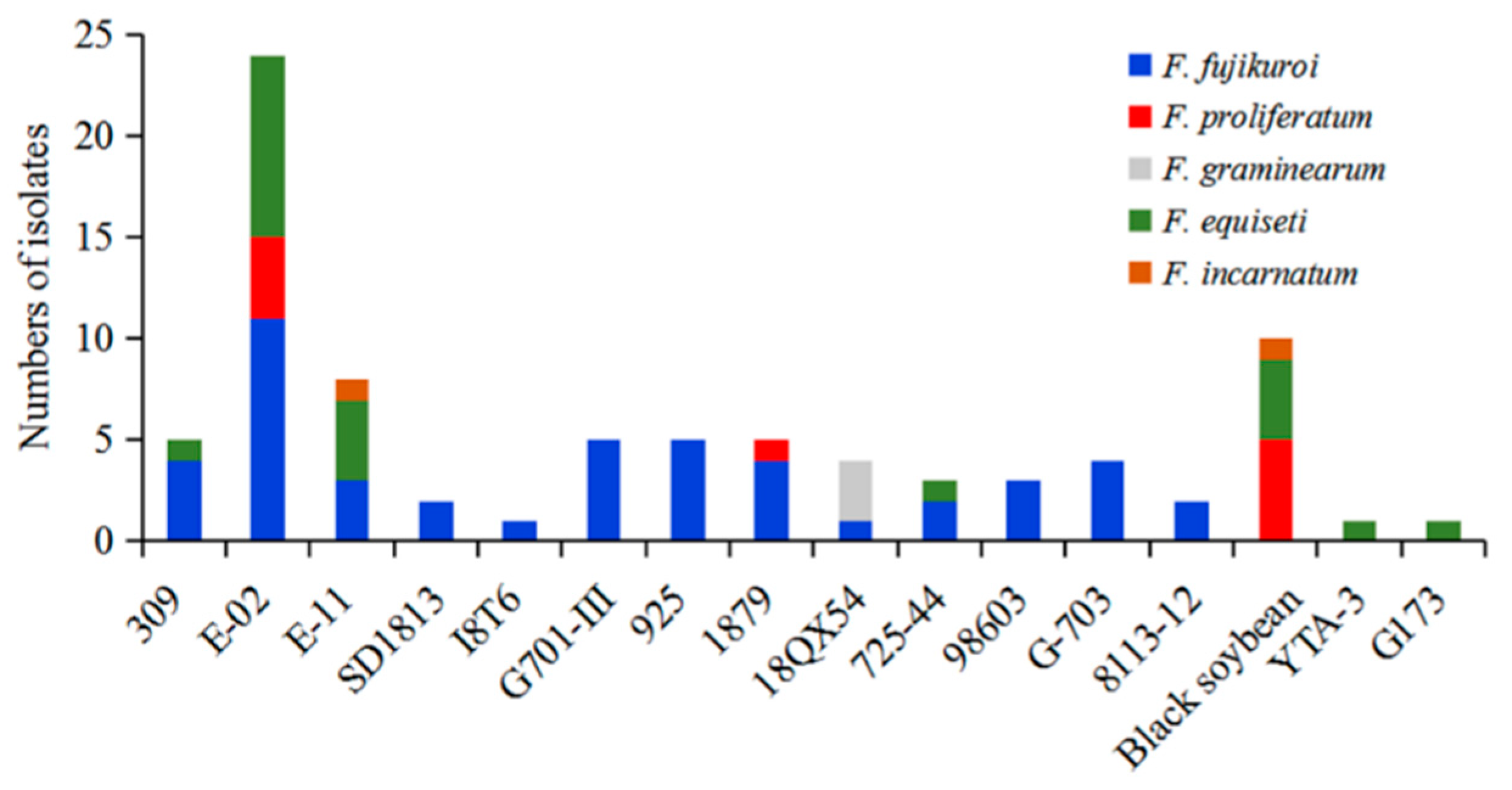
| Isolates | Soybean Cultivars | Sampling Location | Suggested Identification | GenBank Accession Number | |
|---|---|---|---|---|---|
| EF1-α | RPB2 | ||||
| SP01 | 309 | Chongzhou, Sichuan | F. fujikuroi | MK611857 | MN625641 |
| SP02 | 309 | Chongzhou, Sichuan | F. fujikuroi | MK611865 | MN625642 |
| SP03 | 309 | Chongzhou, Sichuan | F. fujikuroi | MK611868 | MN625643 |
| SP04 | 309 | Changzhou, Sichuan | F. fujikuroi | MK611861 | MN625644 |
| SP004 | 309 | Changzhou, Sichuan | F. equiseti | MK611911 | MN625626 |
| SP10 | E-02 | Chongzhou, Sichuan | F. fujikuroi | MK611843 | MN625645 |
| SP010 | E-02 | Chongzhou, Sichuan | F. fujikuroi | MK611871 | MN625669 |
| SP13 | E-02 | Chongzhou, Sichuan | F. fujikuroi | MK611874 | MN625672 |
| SP14 | E-02 | Chongzhou, Sichuan | F. fujikuroi | MK611858 | MN625659 |
| SP19 | E-02 | Chongzhou, Sichuan | F. fujikuroi | MK611844 | MN625646 |
| SP20 | E-02 | Chongzhou, Sichuan | F. fujikuroi | MK611869 | MN625667 |
| SP21 | E-02 | Chongzhou, Sichuan | F. fujikuroi | MK611863 | MN625663 |
| SP28 | E-02 | Chongzhou, Sichuan | F. fujikuroi | MK611864 | MN625664 |
| SP32 | E-02 | Chongzhou, Sichuan | F. fujikuroi | MK611870 | MN625668 |
| SP07 | E-02 | Chongzhou, Sichuan | F. equiseti | MK611917 | MN625632 |
| SP08 | E-02 | Chongzhou, Sichuan | F. equiseti | MK611923 | MN625638 |
| SP12 | E-02 | Chongzhou, Sichuan | F. equiseti | MK611921 | MN625636 |
| SP16 | E-02 | Chongzhou, Sichuan | F. equiseti | MK611913 | MN625628 |
| SP23 | E-02 | Chongzhou, Sichuan | F. equiseti | MK611912 | MN625627 |
| SP30 | E-02 | Chongzhou, Sichuan | F. equiseti | MK611919 | MN625634 |
| SP31 | E-02 | Chongzhou, Sichuan | F. equiseti | MK611922 | MN625637 |
| SP24 | E-02 | Chongzhou, Sichuan | F. proliferatum | MK611898 | MN625696 |
| SP27 | E-02 | Chongzhou, Sichuan | F. proliferatum | MK611892 | MN625690 |
| SP027 | E-02 | Chongzhou, Sichuan | F. proliferatum | MK611889 | MN625687 |
| SP29 | E-02 | Chongzhou, Sichuan | F. proliferatum | MK611890 | MN625688 |
| SP34 | Black soybean | Chongzhou, Sichuan | F. equiseti | MK611920 | MN625635 |
| SP35 | Black soybean | Chongzhou, Sichuan | F. equiseti | MK611916 | MN625631 |
| SP36 | Black soybean | Chongzhou, Sichuan | F. equiseti | MK611914 | MN625629 |
| SP43 | Black soybean | Renshou, Sichuan | F. equiseti | MK611910 | MN625625 |
| SP37 | Black soybean | Renshou, Sichuan | F. proliferatum | MK611897 | MN625695 |
| 037 | Black soybean | Renshou, Sichuan | F. proliferatum | MK611894 | MN625692 |
| SP39 | Black soybean | Renshou, Sichuan | F. proliferatum | MK611893 | MN625691 |
| SP039 | Black soybean | Renshou, Sichuan | F. proliferatum | MK611891 | MN625689 |
| SP40 | Black soybean | Renshou, Sichuan | F. proliferatum | MK611896 | MN625694 |
| SP44 | Black soybean | Renshou, Sichuan | F. incarnatum | MK611902 | MN625700 |
| SP52 | E-11 | Zigong, Sichuan | F. fujikuroi | MK611880 | MN625678 |
| SP53 | E-11 | Jianyang, Sichuan | F. fujikuroi | MK611873 | MN625671 |
| SP053 | E-11 | Jianyang, Sichuan | F. fujikuroi | MK611866 | MN625665 |
| SP47 | E-11 | Renshou, Sichuan | F. equiseti | MK611907 | MN625622 |
| SP48 | E-11 | Zigong, Sichuan | F. equiseti | MK611908 | MN625623 |
| SP49 | E-11 | Zigong, Sichuan | F. equiseti | MK611909 | MN625624 |
| SP50 | E-11 | Zigong, Sichuan | F. equiseti | MK611905 | MN625620 |
| SP51 | E-11 | Zigong, Sichuan | F. incarnatum | MK611903 | MN625701 |
| SP58 | E-02 | Jianyang, Sichuan | F. fujikuroi | MK611879 | MN625677 |
| SP61 | E-02 | Jianyang, Sichuan | F. fujikuroi | MK611862 | MN625662 |
| SP60 | E-02 | Jianyang, Sichuan | F. equiseti | MK611906 | MN625621 |
| SP62 | E-02 | Jianyang, Sichuan | F. equiseti | MK611918 | MN625633 |
| SP70 | YT-A3 | Chongzhou, Sichuan | F. equiseti | MK611915 | MN625630 |
| SP74 | SD18113 | Renshou, Sichuan | F. fujikuroi | MK611854 | MN625656 |
| SP75 | SD18113 | Renshou, Sichuan | F. fujikuroi | MK611867 | MN625666 |
| SP81 | I8T6 | Renshou, Sichuan | F. fujikuroi | MK611852 | MN625654 |
| SP84 | G701-III | Zigong, Sichuan | F. fujikuroi | MK611842 | MN625640 |
| SP85 | G701-III | Zigong, Sichuan | F. fujikuroi | MK611859 | MN625660 |
| SP86 | 925 | Zigong, Sichuan | F. fujikuroi | MK611882 | MN625680 |
| SP87 | 925 | Zigong, Sichuan | F. fujikuroi | MK611848 | MN625650 |
| SP89 | 701-III | Zigong, Sichuan | F. fujikuroi | MK611885 | MN625683 |
| SP90 | 701-III | Zigong, Sichuan | F. fujikuroi | MK611855 | MN625657 |
| SP91 | 701-III | Zigong, Sichuan | F. fujikuroi | MK611888 | MN625686 |
| SP94 | 1879 | Nanchong, Sichuan | F. fujikuroi | MK611881 | MN625679 |
| SP95 | 1879 | Nanchong, Sichuan | F. fujikuroi | MK611877 | MN625675 |
| SP97 | 1879 | Nanchong, Sichuan | F. fujikuroi | MK611860 | MN625661 |
| SP98 | 1879 | Nanchong, Sichuan | F. fujikuroi | MK611887 | MN625685 |
| SP097 | 1879 | Nanchong, Sichuan | F. proliferatum | MK611895 | MN625693 |
| SP107 | 18QX54 | Nanchong, Sichuan | F. fujikuroi | MK611846 | MN625648 |
| SP99 | 18QX54 | Nanchong, Sichuan | F. graminearum | MK611899 | MN625697 |
| SP100 | 18QX54 | Nanchong, Sichuan | F. graminearum | MK611901 | MN625698 |
| SP102 | 18QX54 | Nanchong, Sichuan | F. graminearum | MK611900 | MN625699 |
| SP110 | 725–44 | Nanchong, Sichuan | F. fujikuroi | MK611872 | MN625670 |
| 0110 | 725–44 | Nanchong, Sichuan | F. fujikuroi | MK611851 | MN625653 |
| SP111 | 725–44 | Nanchong, Sichuan | F. equiseti | MK611924 | MN625638 |
| SP113 | 925 | Nanchong, Sichuan | F. fujikuroi | MK611878 | MN625676 |
| SP114 | 925 | Nanchong, Sichuan | F. fujikuroi | MK611875 | MN625673 |
| SP115 | 925 | Nanchong, Sichuan | F. fujikuroi | MK611853 | MN625655 |
| SP117 | 98603 | Nanchong, Sichuan | F. fujikuroi | MK611883 | MN625681 |
| SP118 | 98603 | Nanchong, Sichuan | F. fujikuroi | MK611876 | MN625674 |
| SP119 | 98603 | Jianyang, Sichuan | F. fujikuroi | MK611850 | MN625652 |
| SP120 | G-703 | Jianyang, Sichuan | F. fujikuroi | MK611845 | MN625647 |
| SP121 | G-703 | Jianyang, Sichuan | F. fujikuroi | MK611884 | MN625682 |
| SP122 | G-703 | Jianyang, Sichuan | F. fujikuroi | MK611847 | MN625649 |
| SP123 | G-703 | Jianyang, Sichuan | F. fujikuroi | MK611849 | MN625651 |
| SP125 | G173–12 | Jianyang, Sichuan | F. equiseti | MK611904 | MN625619 |
| SP127 | 8113–12 | Jianyang, Sichuan | F. fujikuroi | MK611886 | MN625684 |
| SP129 | 8113–12 | Jianyang, Sichuan | F. fujikuroi | MK611856 | MN625658 |
| Fusarium Species | Growth Rate (cm/day) | Colony Characterization | Macroconidia | |||
|---|---|---|---|---|---|---|
| Septum | Length | Width | Shape | |||
| F. fujikuroi | 4.08 ± 0.26 c | Pale grey color (front), pale yellowish color (back) | 3–5 | 40.38 ± 2.91 b 44.78–36.02 | 2.48 ± 0.23 c 3.17–2.17 | Falcate |
| F. proliferatum | 3.30 ± 0.02 d | Pale grey color (front), pale grey (back) | 3–4 | 39.65 ± 7.88 b 50.33–30.59 | 3.69 ± 0.90 b 5.41–1.86 | Falcate, fusiform |
| F. graminearum | 5.34 ± 0.22 a* | White yellowish (front), purple (back) | 4–6 | 45.90 ± 4.40 a* 48.81–31.43 | 4.42 ± 0.75 a* 5.14–2.32 | Falcate |
| F. equiseti | 4.62 ± 0.44 b | Pale grey color (front), ginger yellowish (back) | 3–4 | 29.61 ± 3.84 e 34.46–21.47 | 3.12 ± 0.43 c 4.05–2.01 | Falcate |
| F. incarnatum | 4.92 ± 0.19 ab | Pale grey color(front), yellowish color (back) | 3–4 | 37.46 ± 4.98 c 47.02–33.57 | 4.03 ± 1.06 b 5.89–1.86 | Falcate |
| Isolate name | Isolate ID | Percentage of Mycelium Covering (PMC) | Seed Weight (g) | Root Length (CM) | Germination Rate (%) | Disease Severity Index (DSI) |
|---|---|---|---|---|---|---|
| control | C01 | 0 g* | 0.91 ± 0.05 a* | 3.30 ± 0.17 a* | 100 ± 0 a* | 0 g* |
| C02 | 0 g | 0.84 ± 0.09 ab | 2.93 ± 0.35 ab | 100 ± 0 a | 0 g | |
| C03 | 0 g | 0.82 ± 0.11 abc | 3.21 ± 0.63 a | 100 ± 0 a | 0 g | |
| F. fujikuroi | SP95 | 82.00 ± 19.05 ab | 0.40 ± 0.01 j | 1.04 ± 1.15 efgh | 57.33 ± 15.01 d | 70.50 ± 7.77 a |
| SP14 | 82.10 ± 13.74 ab | 0.42 ± 0.01 j | 1.15 ± 0.63 c | 55.00 ± 25.35 d | 70.04 ± 2.42 a | |
| SP59 | 90.88 ± 3.66 a | 0.47 ± 0.02 ij | 1.01 ± 0.75 fghi | 57.66 ± 6.80 d | 71.66 ± 7.07 a | |
| F. equiseti | SP30 | 59.66 ± 13.50 cd | 0.50 ± 0.02 hij | 0.99 ± 0.33 ghi | 77.33 ± 15.01 bcd | 64.15 ± 5.89 bc |
| SP31 | 70.99 ± 20.18 bc | 0.50 ± 0 hij | 0.61 ± 0.42 i | 79.66 ± 17.38 abc | 60.00 ± 0 bcd | |
| SP08 | 71.10 ± 3.80 abc | 0.61 ± 0.01 fghi | 0.72 ± 0.40 hi | 79.66 ± 11.54 abc | 60.83 ± 3.53 ab | |
| F. graminearum | SP99 | 56.00 ± 20.00 cde | 0.59 ± 0.03 hij | 1.78 ± 0.05 defg | 76.00 ± 10 bcd | 55.83 ± 5.89 bcd |
| SP100 | 52.22 ± 10.18 cde | 0.62 ± 0.04 fghi | 1.75 ± 0.32 defg | 66.63 ± 23.71 cd | 55.83 ± 3.53 bcd | |
| SP102 | 57.55 ± 14.14 cd | 0.65 ± 0.01 efg | 1.47 ± 0.34 efghi | 77.33 ± 7.50 bcd | 59.99 ± 2.35 bcd | |
| F. proliferatum | SP29 | 28.44 ± 4.23 ef | 0.68 ± 0.05 defg | 2.54 ± 0.14 defgh | 77.33 ± 14.01 bcd | 45.83 ± 8.24 ef |
| SP24 | 35.33 ± 10.47 ef | 0.65 ± 0.03 efg | 2.07 ± 0.78 bcde | 79.66 ± 17.38 abc | 43.33 ± 0 ef | |
| SP37 | 37.55 ± 14.14 e | 0.70 ± 0.07 def | 1.95 ± 0.13 cdef | 88.33 ± 4.04 ab | 49.16 ± 1.18 de | |
| F. incarnatum | SP44 | 24.00 ± 3.46 f | 0.73 ± 0.05 cde | 2.71 ± 0.11 abc | 88.33 ± 4.04 ab | 35..83 ± 8.24 f |
| SP51 | 26.44 ± 6.3 f | 0.76 ± 0.08 bcd | 1.84 ± 0.17 abc | 81.66 ± 14.01 abc | 40.44 ± 2.11 f |
© 2019 by the authors. Licensee MDPI, Basel, Switzerland. This article is an open access article distributed under the terms and conditions of the Creative Commons Attribution (CC BY) license (http://creativecommons.org/licenses/by/4.0/).
Share and Cite
Naeem, M.; Li, H.; Yan, L.; Raza, M.A.; Gong, G.; Chen, H.; Yang, C.; Zhang, M.; Shang, J.; Liu, T.; et al. Characterization and Pathogenicity of Fusarium Species Associated with Soybean Pods in Maize/Soybean Strip Intercropping. Pathogens 2019, 8, 245. https://doi.org/10.3390/pathogens8040245
Naeem M, Li H, Yan L, Raza MA, Gong G, Chen H, Yang C, Zhang M, Shang J, Liu T, et al. Characterization and Pathogenicity of Fusarium Species Associated with Soybean Pods in Maize/Soybean Strip Intercropping. Pathogens. 2019; 8(4):245. https://doi.org/10.3390/pathogens8040245
Chicago/Turabian StyleNaeem, Muhammd, Hongju Li, Li Yan, Muhammad Ali Raza, Guoshu Gong, Huabao Chen, Chunping Yang, Min Zhang, Jing Shang, Taiguo Liu, and et al. 2019. "Characterization and Pathogenicity of Fusarium Species Associated with Soybean Pods in Maize/Soybean Strip Intercropping" Pathogens 8, no. 4: 245. https://doi.org/10.3390/pathogens8040245
APA StyleNaeem, M., Li, H., Yan, L., Raza, M. A., Gong, G., Chen, H., Yang, C., Zhang, M., Shang, J., Liu, T., Chen, W., Fahim Abbas, M., Irshad, G., Ibrahim Khaskheli, M., Yang, W., & Chang, X. (2019). Characterization and Pathogenicity of Fusarium Species Associated with Soybean Pods in Maize/Soybean Strip Intercropping. Pathogens, 8(4), 245. https://doi.org/10.3390/pathogens8040245





